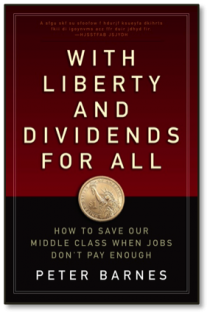With Liberty and Dividends For All

From the Introduction
WE LIVE IN complicated times. We have far more problems than solutions, and most of our problems are wickedly complex. That said, it’s sometimes the case that a simple idea can spark profound changes, much as a small wind can become a hurricane. This happened with such ideas as the abolition of slavery, equal justice under law, universal suffrage, and racial and sexual equality.
This book is about another simple idea that could have comparable effects in the twenty-first century. The idea is that all persons have a right to income from wealth we inherit or create together. That right derives from our equality of birth. And the time to implement it has arrived.
Why is this? America today is on the brink of losing its historic vision. From our beginnings we aspired to build a meritocratic middle class, and by the mid-twentieth century we had substantially done so. Though millions of Americans remained marginalized, our median income—the income that half of Americans earn more than—was enough for a family to live comfortably on, often with only one wage earner. Further, most Americans assumed that their children would live better than they did—in other words, that our broad middle class would not only survive but expand.
But that’s not what happened. As we approached and then entered the twenty-first century, our economy continued to grow, but almost all of its gains flowed to a wealthy few. This disturbing fact has been amply noted by presidents and many others, but what hasn’t yet been identified is a remedy that can fix it. This book contends that paying dividends from wealth we own together is a practical, market-based way to assure the survival of a large middle class. It can be implemented by electronically wiring such dividends to every legal resident, one person, one share.
THE CORE OF THIS IDEA isn’t new. Thomas Paine, the patriot who inspired our war of independence from Britain, proposed something quite like it in 1797. And Alaska has been running a version of it since 1980. The main things that would be new are the scale and the sources of income.
This old/new idea is ready for prime time for two major reasons. One is the lack of alternatives. Our current fiscal and monetary tools can’t sustain a large middle class, nor can increased investment in education, infrastructure, and innovation. None of these old palliatives address the reality that for the foreseeable future, there simply won’t be enough good-paying jobs to maintain a large middle class.
A second reason is the current stalemate in American politics. Solutions to all major problems are trapped in a tug-of-war between advocates of smaller and larger government. Dividends from co-owned wealth bypass that bitter war. They require no new taxes or government programs; once set up, they’re purely market based. And because they send legitimate income to everyone, they can’t help but be popular among voters of all political stripes.
Would dividends from co-owned wealth mean the end of capitalism? Not at all. They would mean the end of winner-take-all capitalism, our currently dominant version, and the beginning of a more balanced version that respects all members of society, including those not yet born. This better-balanced capitalism—perhaps we could call it everyone-gets-a-share capitalism—wouldn’t solve all our problems, but it would do more than any other potential remedy to preserve our middle class, our democracy, and our planet.
REVIEWS
David Roberts in Grist
Sasha Abramsky in The American Prospect
Dwight Murphey in the Journal of Social, Political and Economic Studies
Hazel Henderson in Seeking Alpha
Tom Athanasiou in EcoEquity
 Free distribution with attribution
Free distribution with attribution